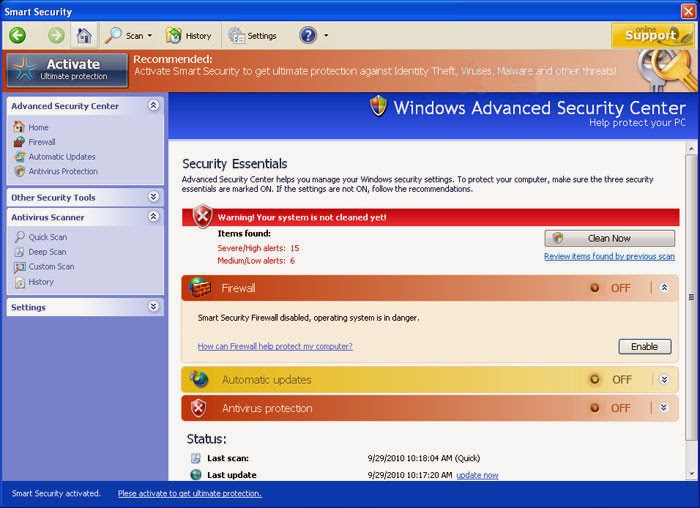- Fake anti-virus program like smart security would install without knowledge and authorization.
- The number of threats reported by smart security would substantially exceed normal range.
- The interface of Smart Security shares a lot with other rogue anti-virus program such as Windows Web Watchdog.
- Browser redirect to registration site always happens.
- PC performance becomes much slower than before and it should be.
How Do I Get Smart Security Fake Anti-virus Program?
Smart Security is categorized as rogueware which is a stand-alone infection. It has its own advertising platform which is what we called spam ads/sites. Such sites are not easily recognized as spam unless one is well equipped with knowledge on websites and computer technologies. Usually, the sites own huge traffic (by some rogue means such hijacking) which is the exact thing that attract many more operators. As a result, the advertising sites of Smart Security gain cooperators, putting Smart Security ads on other sites or bundling it to some third-party programs.
Here’s the conclusion on the ways to get Smart Security:
- Install third-party program (freeware and shareware particularly) with “recommended installation method” without checking the build-in options.
- Random click on some luring ads.
- Affected and taken by browser hijacker/adware to the sites that insert Smart Security’s code into the target machine.
How Dangerous Is Smart Security Fake Anti-virus Program?
The danger largely lies in the registration web page. It is a temporary platform to take money from not only victims’ pockets but also bank cards. How?
To build a site, BHO, Applet, Active and JS technologies will be involved. But these techs can also be utilized maliciously by cyber criminals with rich knowledge in this filed. The counterfeit registration site will not only be enabled to stick to an affected computer but also be enabled to collect the input information concerning bank card account number, password.
Other dangers from Smart Security would be weak security defense. Victims may notice that installed anti-virus program simply become silent against Smart Security infiltration. Why?
By means of the technologies applied on web site building, Smart Security manages to call the background running processes such as explorer.exe and svchost.exe to disable the service regarding security. Besides, to make itself the automatic startup item at each Windows starts, Smart Security fake anti-virus program manages to occupy plenty of CPU and run its bogus scan, leaving little for both security program and service to play fully in protecting a machine.
Given this, manual removal method is highly recommended. But be sure that you are well equipped with virus features and computer skills so that a complete removal can be reached. Any help request will be answered by a recommended PC Security Center if you start a live chat window here with the button.
Instruction to Show the Steps on Removing Smart Security Fake Anti-virus Program from Windows
1.access registry editor and make modifications to remove Smart Security.
a. navigate to the following entries respectively to find suspicious key value started with “Run” and delete accordingly.
HKEY_LOCAL_MACHINE\SOFTWARE\Microsoft\Windows\Current Versionb.navigate to the following entries to remove related ones and remove Smart Security’s startup items.
HKEY_CURRENT_USER\Software\Microsoft\Windows\CurrentVersion
HKEY_CURRENT_USER\Software\Microsoft\Windows\CurrentVersion\Explorer\Shell Folders Startup=”C:\windows\start menu\programs\startup
HKCU\SOFTWARE\Microsoft\Windows\CurrentVersion
HKEY_CURRENT_USER\Software\Microsoft\Windows
HKEY_LOCAL_MACHINE\SOFTWARE\Microsoft\Windows
HKEY_CLASSES_ROOT\.exe “(Default)” = “” [random]
HKEY_LOCAL_MACHINE\SOFTWARE\Microsoft\Windows\CurrentVersion\Uninstall\[random]
2.end Smart Security’s process.
Ctrl,+Alt+Delete (Windows 7/XP/Vista) key combination/ Ctrl + Shift + Esc(Windows 8) > Task Manager > View tab > “Select Columns”> “Image Path Name” and PID > see full path name > end the processes referring the location of Smart Security.
3.uninstall Smart Security from Control Panel, if any.
Windows 7/Vista/XP - Start menu > Control Panel > “Add/Remove Programs” > uninstall Smart Security.
Windows 8 - “Unpin” button > ‘Control Panel’ > "Programs and Features" > uninstall Smart Security.
4.open up random folder; search for and remove everything related to Smart Security.
Before that, it is recommended to show hidden items.
Windows 7/XP/Vista
Control panel > user accounts and family safety >Folder Options > view tab > tick ‘Show hidden files and folders’ > non-tick ‘Hide protected operating system files (Recommended)’.
Windows 8
Windows Explorer > view tab > tick ‘File name extensions’ > tick “hidden items”.
Next open up random folder and hit on Search icon, type "Smart Securiy" in all the search blanks and hit Enter button so as to remove all the detection.
Note:
The above instruction is showing the thread for victims. It should be understood that the items generated by Smart Security are not possible to be listed here as they could increase in numbers according to the length of infiltrating period and some improvements will be made to the fake anti-virus program via backdoor program to deter effective removal. That’s why quick fix is appealed. By the way, if one suffers from additional infections, one should remove them altogether so that Smart Security won’t stage a comeback before long.





No comments:
Post a Comment